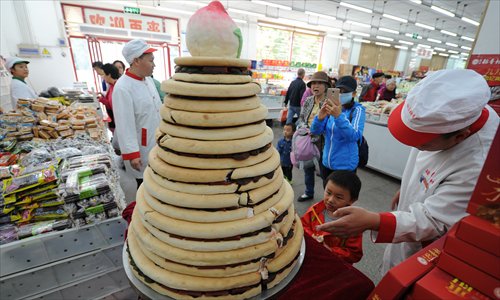Double ninth feast
What to eat during the traditional autumn festival

A Chongyanggao made in Changzhou, Jiangsu Province Photo: IC

A baker displays an 80-centimeter high Chongyanggao in Beijing on October 18. Photo: IC
On Wednesday, all of China celebrated the Double Ninth Festival. Together with Chinese New Year's Eve, Tomb Sweeping Day (Qingming) and Zhongyuan Festival, there are four ancestor-worshiping festivals. The Double Ninth Festival, as the name implies, is on the ninth day of the ninth month in lunar calendar.
Its origin date back to the Warring States Period (475 BC - 221 BC) but it was not officially recognized as a festival until the Tang Dynasty (618 - 907). In 1989, it was designated as Senior's Day, a day to respect the elderly and to let them enjoy themselves.
Family members usually go traveling together, climbing hills or mountains to take in breathtaking views, often taking branches of zhuyu or Euodia, a plant genus in the Rutaceae family, to place in their homes.
In ancient times, Double Ninth Festival was believed to be a festival of luck and longevity, because nine is the largest number among single digits. The number appears twice on the ninth day of the ninth month of the lunar new year, hence the name Double Ninth Festival.
The ninth lunar month is also the month that Chinese chrysanthemums bloom, so it is also referred to as the Chrysanthemum Festival. The Chrysanthemum plant has a special meaning in Chinese culture. Since it blooms even in cold weather, it has been portrayed in some ancient poems as a symbol of vitality, exemplary conduct and nobility of character. Eating food made from the chrysanthemum plant is thought to bring luck and longevity as well.
Chongyanggao (double ninth cake)
According to legend, a kind farmer who lives under a hill helped and entertained an elderly man he found on his way home. In return, the man told him about a disaster that will happen to him on the day of Double Ninth. He advised him to move to a high place with fewer plants. The farmer did as he was told.
On the day of Double Ninth, the farmer's previous house was engulfed in fire, which spread to the hill. But he avoided the disaster because he listened to the elder.
That's how "climbing hills or mountains" became a custom.
But journeying to the mountainside every year can be exhausting, and some places are plain without interesting scenery. So some people came up with the idea of making gao, or cake, which has the same pronunciation as "high" in Chinese. Today, the word also means "going up," as in a wish for making progress.
Chongyang cake is also called chrysanthemum cake and five color cake, and there is no fixed rule as to how it can be made.
The ingredients for making the cake are separated into three different kinds. There are those to make the skin, which includes flour, oil and water, those to make the cake crispy, including milk and oil, and those to make stuffings such as jujube paste, peanuts, raisins, black sesames, green pepper, rice powder, sesame oil, honey and sweet-scented osmanthus.
Some tend to stuff the cake with jujube, walnuts while others make it into two or three layers, stuffed with fruits preserves. There are even those who make them small like coins. After being baked, the cake is tender with a crispy skin and gives off the scent of fruit trees.
Chongyang cakes are sold in many stores that make traditional Chinese desserts, like Daoxiangcun. For this year's festival, they made a multi-layer chongyang cake with a height of 80cm and a diameter of 70cm with a peach-shaped mantou on the top as a blessing for longevity.
Chrysanthemum wine
During this festival, people drink chrysanthemum wine, which is believed to be auspicious and can dispel bad things.
Poet Qu Yuan(340BC- 278BC) portrayed eating chrysanthemum petals in his works. Chrysanthemum wine was present in the Han Dynasty (206BC -AD 220). Herbs, including Rehmannia, Angelica, and Medlar, were added to it during the Ming and Qing dynasties.
Many believe that chrysanthemum wine can help dispel inner body heat and nourish the liver to improve visual acuity. They also believe that it has anti-inflammatory and detoxification properties so it's also regarded a medicinal liquor.
In ancient times, chrysanthemum wine was brewed a year in advance on the day of Double Ninth Festival. On the ninth, chrysanthemum petals that just bloomed are picked, together with a few leaves and then added to grains that will be used to brew the following year's wine.
Chrysanthemum feast
If the cake and wine sound too complicated, it's also possible to cook main dishes with chrysanthemum by yourself at home.
Chrysanthemum chicken soup
Wash a handful of chrysanthemum petals, and cut a chicken into thin slices. Add water to a pot with pieces of chicken or chicken bones and bring it to boil. Add oil and fish sauce. When the soup starts to boil, add the chicken slices and the petals.
Don't boil the meat and petals for a long time, since they won't be tender. The chicken soup tastes meaty yet with a fresh scent.
Stir fried chrysanthemum & meat
Pick the lean part of pork and shred it. Mixed in potato powder, salt and a bit water, so the pork will taste very tender.
Heat some oil and stir fry the pork adding sauces and the petals. It's that simple.
Chrysanthemum fish
Steamed perch is a common dish in many households and restaurants.
The fish is steamed whole and seasoned with only soybean sauce, scallions, and ginger so that the flavor of a fish stands out. But adding some yellow and white chrysanthemum petals when steaming the fish is still worth trying.
Chrysanthemum petals can also be added when making rice porridge.